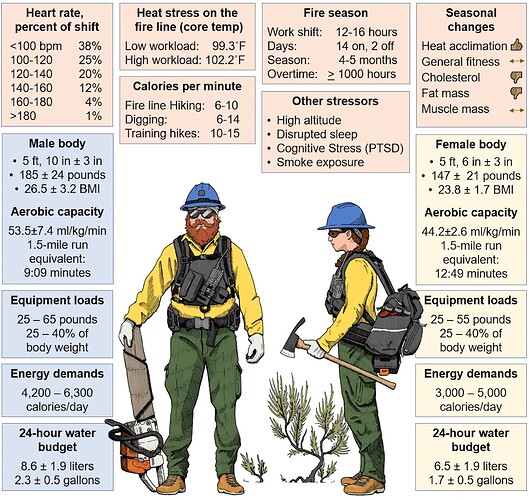The crew is participating in a study that my team from Montana is conducting to measure the physical strain and total energy demands of work on an active wildfire, with the goal of finding ways to improve firefighter fueling strategies and ultimately health and safety on the line.
Also, I hazard, none of them were forced by Freedom to wear camo. Have a nice day.
5 Likes
“Still, with the immense physical demands of the job, crew members often experience a decay in metabolic and cardiovascular health and an increase in cholesterol, blood lipids and body fat. It is unclear why such a hardworking job often makes firefighters less healthy, requiring an off-season reset to recover, retrain and rebuild.”
This paragraph really stands out to me. It just goes to prove that sleeping in the dirt, the lack of showers and laundering abilities at base camp, the constant exposure to burnt material, and the constant feeding of a typical western American diet are still a detriment even when burning an immense amount of calories, sometimes for months at a time during the summer. Now tack on the fact that the FEDS just made everyone a permanent position on a shot crew and it potentially detracts that winter layoff period to reset your body to get ready for the next fire season.
The season causes damage. This unfolds counter to the commonly accepted benefits of regular exercise. Pollutant and smoke exposure, lapses in nutrition, sleep disorders and chronic stress during the season seems to gradually poke holes in the Hotshot armor.
Progressive intervention strategies can help, such as educational programs to inform specific physical training and nutritional needs, mindfulness training to reduce the risk of job-oriented anxiety and depression and emotional support for individual crew members and families.
‘intervention strategy’
- educational programs to inform specific physical training and nutritional needs
- mindfulness training to reduce the risk of job-oriented anxiety and depression
- and emotional support for individual crew members and families
Not sure what the difference is between points two and three. Reads as too abstract and detached. Besides, they already do all this. It’s called “fire training”. I suppose if you’re a bike racing fan, it’s a flattering comparison, but I’m not sure Tour de France stands up. The writer clearly withholds any criticism of the dark side of Tour de France.
It’s not a sport, it’s not entertainment, it’s not training your body to be a model, or a symbol. It’s not an environment designed to make you a more attractive entertainment product, or to ensure you have a profitable off-season signing autographs and hanging out with a talk show crowd discussing diets, interventions and eternal flames. Its combat with a wild force of nature that kills you, your friends and the innocent public if you do it wrong. And, after PTSD settles in, it’s a fight to the death.
Perhaps, the stress can be addictive and make you think like an anthropological study of the ‘hunter in winter’, or a hibernating bear. Nobody talks about Tour de France like they are stupid grunts. But, they sure aren’t afraid of talking about wildland firefighters, like that.
I like the facts and figures presented in the article, though the tone is somewhat shallow.
2 Likes
I do find the last paragraph “A large, warm meal starts to reload precious muscle fuel.” Somewhat comical.
As a generalization … The meals provided by federal food caterers are anything but large. In fact if you couple the so-called hot meals with the issued daily lunch it’s no wonder that there is physical and mental degradation over varied amounts of time whether it’s a role a shift or a season. It’s already plainly stated that lying personnel can burn 4 to 6,000 calories and by no means is that what is issued just in caloric value alone. If you look in the back of a buggy you’ll see that most pack their own upgraded pocket foods and subsistence…
I think it was circa 2012 maybe 2011 when CF had a self-formed group from logistics section that started evaluating lunch qualities and contents. It was about this time when the 24-hour lunch as it’s called probably doubled in caloric intake, reduced in sugar content and mixed in duration of release from proteins and quick hit carbs.
AKA Pocket foods.
What is the “team” performing this study?
3 Likes
What is the “team” performing this study?
No clue, really. Just another striper pulled from the river of news.
